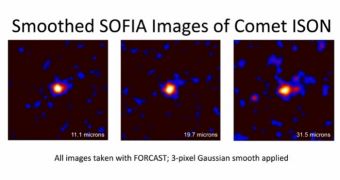On October 24, 2013, NASA and the German Aerospace Center (DLR) conducted a new target-of-opportunity flight using the Stratospheric Observatory for Infrared Astronomy (SOFIA). The purpose of this flight, among others, was to capture an image of Comet ISON as it nears the Sun.
SOFIA is the world's only airborne telescope. The 2.5-meter observatory is installed in the tail section of a heavily-modified Boeing 747SP aircraft. It was developed by researchers and engineers at DLR and in Europe, with input from NASA. The American space agency provided the Boeing airplane.
Comet Nevski–Novichonok, popularly known as ISON or C/2012 S1, has been the focus of numerous astronomical observations over the past few months. It was first discovered on September 21, 2012, when astronomers figured out that it belongs to the sungrazing family.
This means that Comet ISON will fly very close to the Sun during its perihelion, on November 28. At this point, there is no way of knowing whether or not this close encounter will destroy the space rock, but the fact remains that it will lose a lot, if not all, of its ices as it flies past the Sun.
As the object nears the center of the solar system, astronomers with the SOFIA collaboration decided to use the airborne observatory to capture an image of Comet ISON. They hypothesized that the photo would be very faint, which was indeed the case.
The airborne telescope is based at the NASA Dryden Aircraft Operations Facility, in Palmdale, California. For its latest sortie, it first flew east over Colorado, and then turned northeast to fly over Ontario, Canada. It then moved across the province of Alberta before turning back south to the US.
This 10-hour flight was necessary to put SOFIA in a correct position for viewing Comet ISON. The observatory began collecting data once it reached an altitude of 13,100 meters (43,000 feet).
“The long wavelength photometry, only possible from SOFIA, will allow us to measure the thermal emission from larger grains, which cannot be seen in scattered light at visible wavelengths,” said SOFIA principal investigator Diane Wooden.
“Compared with smaller submicron grains, larger grains have cooler temperatures and emit at longer wavelengths,” adds the expert, who is based at the NASA Ames Research Center. The Faint Object InfraRed CAmera for the SOFIA Telescope (FORCAST) instrument is perfect for such measurements of the dust grains in the coma (tail) of the comet.

 14 DAY TRIAL //
14 DAY TRIAL //